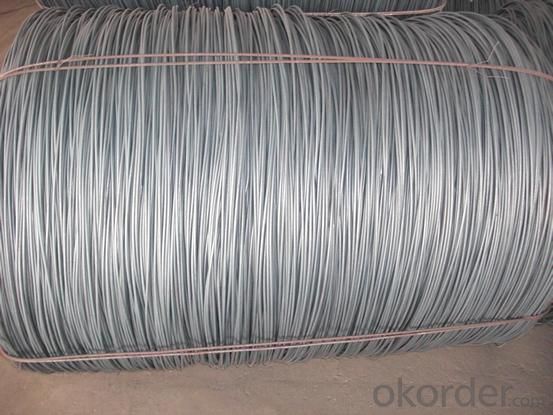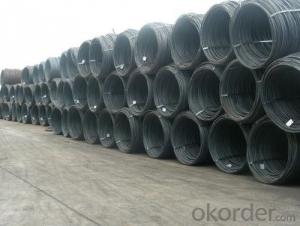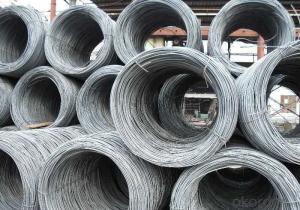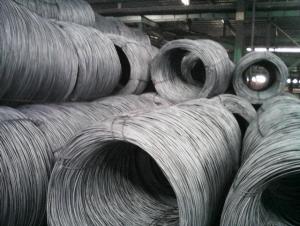Hot Rolled Wire Rod 5.5mm-14mm SAE1008 or SAE1006
- Loading Port:
- Tianjin
- Payment Terms:
- TT OR LC
- Min Order Qty:
- 25 m.t.
- Supply Capability:
- 200000 m.t./month
OKorder Service Pledge
OKorder Financial Service
You Might Also Like
Product Description:
OKorder is offering high quality Hot Rolled Steel I-Beams at great prices with worldwide shipping. Our supplier is a world-class manufacturer of steel, with our products utilized the world over. OKorder annually supplies products to European, North American and Asian markets. We provide quotations within 24 hours of receiving an inquiry and guarantee competitive prices.
Product Applications:
After hot-rolled the products shaped into coil and delivery as finished product, including round, square, rectangular, hexagonal and so on. Since most of the products are round, it is generally called wire rod. Carbon steel wire rod is widely used in construction and manufacturing. Carbon steel wire rod is mainly used for reinforcement of reinforced concrete and welded structure or reprocessed (roberts , nail, etc.) materials, especially used to produce wire drawing, welding electrode, nails, spring, electronic, precise machinery parts and so on.
Product Advantages:
OKorder's Steel I-Beams are durable, strong, and resist corrosion.
Main Product Features:
· Premium quality
· Prompt delivery & seaworthy packing (30 days after receiving deposit)
· Corrosion resistance
· Can be recycled and reused
· Mill test certification
· Professional Service
· Competitive pricing
Product Specifications:
Manufacture: Hot rolled
Grade: SAE1008 SAE 1006
Certificates: ISO, SGS, BV, CIQ
Diameter: 5.5mm, 6.5mm, 7mm,8mm,9mm,10mm,12mm,14mm, as per customer request
Packaging: Export packing, nude packing, bundled
Grade | Chemical Composition (%) | |||||
C | Mn | S | P | Si | B | |
SAE1008B | 0.10max | 0.32max | 0.045max | 0.040max | 0.30max | 0.0008min |
Mechanical properties | ||||||
Yield strength(N/mm2) | Tensile strength(N/mm2) | Elongation (%) | ||||
≥195 | 350-380 | ≥32 | ||||
FAQ:
Q1: Why buy Materials & Equipment from OKorder.com?
A1: All products offered byOKorder.com are carefully selected from China's most reliable manufacturing enterprises. Through its ISO certifications, OKorder.com adheres to the highest standards and a commitment to supply chain safety and customer satisfaction.
Q2: How do we guarantee the quality of our products?
A2: We have established an advanced quality management system which conducts strict quality tests at every step, from raw materials to the final product. At the same time, we provide extensive follow-up service assurances as required.
Q3: How soon can we receive the product after purchase?
A3: Within three days of placing an order, we will begin production. The specific shipping date is dependent upon international and government factors, but is typically 7 to 10 workdays.


- Q: Can steel wire rod be used in high-temperature applications?
- Steel wire rod can be used in high-temperature applications, but it is important to consider the specific type of steel used and the temperatures involved. Certain grades of steel, such as stainless steel or heat-resistant alloys, are specifically designed to withstand high temperatures without significant loss of strength or structural integrity. These types of steel are often used in industries such as aerospace, automotive, and power generation, where exposure to high temperatures is common. However, not all steel wire rods are suitable for high-temperature applications. Some lower-grade steels may experience a decrease in mechanical properties, such as tensile strength, ductility, and corrosion resistance, when exposed to elevated temperatures. It is crucial to consult the manufacturer's specifications or seek expert advice to determine if a particular steel wire rod is appropriate for the intended high-temperature environment. Additionally, other factors such as the operating conditions, duration of exposure, and presence of other corrosive elements or chemicals should be taken into account when considering the use of steel wire rod in high-temperature applications. Regular monitoring and maintenance may be necessary to ensure the continued performance and safety of the steel wire rod in such environments.
- Q: What are the standard bending requirements for steel wire rod?
- The standard bending requirements for steel wire rod depend on the specific application and industry standards. However, some common bending requirements for steel wire rod include achieving a specific radius or angle without causing cracking, breaking, or excessive deformation of the material. These requirements are often specified in terms of minimum bend radii, maximum bend angles, and acceptable levels of distortion or elongation. It is important to consult the relevant industry standards and guidelines to ensure compliance with the specific bending requirements for steel wire rod.
- Q: How is steel wire rod used in the manufacturing of wire forms for automotive exhaust systems?
- Steel wire rod is a crucial component in the manufacturing of wire forms for automotive exhaust systems. These wire forms are used to provide structural support and stability to the exhaust system, ensuring its proper functioning and longevity. Firstly, steel wire rod is used to create the main framework of the wire form, which serves as the backbone of the exhaust system. This framework is responsible for holding and positioning various components of the exhaust system, such as the muffler, catalytic converter, and pipes. The high tensile strength and durability of steel wire rod make it an ideal choice for this application, as it can withstand the intense vibrations, heat, and pressure that the exhaust system is subjected to. Additionally, steel wire rod is used to form the hangers and brackets that secure the exhaust system to the vehicle's chassis. These hangers and brackets are essential for maintaining the proper alignment and stability of the exhaust system, preventing any unnecessary movement or rattling. The flexibility and malleability of steel wire rod allow it to be easily shaped and formed into the desired hanger or bracket design, ensuring a precise fit and reliable performance. Furthermore, steel wire rod is also utilized in the fabrication of wire mesh screens and filters that are installed within the exhaust system. These screens and filters are responsible for trapping and removing contaminants, such as particulate matter and harmful gases, from the exhaust gases before they are released into the environment. The high strength and corrosion resistance of steel wire rod make it an excellent choice for constructing these screens and filters, as they need to withstand the harsh operating conditions and exposure to corrosive elements. In summary, steel wire rod plays a crucial role in the manufacturing of wire forms for automotive exhaust systems. Its high tensile strength, durability, flexibility, and corrosion resistance make it an ideal material for creating the main framework, hangers, brackets, and screens/filters within the exhaust system. By using steel wire rod, manufacturers can ensure that the wire forms provide the necessary structural support, stability, and reliability required for proper functioning of the automotive exhaust system.
- Q: How is steel wire rod used in the production of wire mesh for erosion control?
- Steel wire rod is used in the production of wire mesh for erosion control as it serves as the primary material for creating the mesh structure. The steel wire rod is first processed and shaped into thin, continuous wires. These wires are then woven or welded together to form a mesh pattern, which provides strength, stability, and durability to the wire mesh. This mesh is crucial in preventing soil erosion by acting as a barrier and retaining the soil in place, thereby protecting slopes, embankments, and other vulnerable areas from erosion caused by water or wind.
- Q: What are the common machining methods for steel wire rod?
- The common machining methods for steel wire rod include cutting, bending, drawing, and threading.
- Q: How is steel wire rod used in the production of electrical cables?
- Steel wire rod is used in the production of electrical cables as it serves as the core strength component. It provides structural support and enhances the durability and tensile strength of the cable. The steel wire rod is typically wrapped around the conductor and acts as a protective layer, preventing the cable from stretching or breaking under tension. Additionally, it helps to maintain the shape and integrity of the cable, ensuring reliable transmission of electricity.
- Q: What are the advantages of using steel wire rod in medical applications?
- There are several advantages to using steel wire rod in medical applications. Firstly, steel wire rod offers exceptional strength and durability, making it ideal for use in medical devices and equipment that require high load-bearing capacity. Additionally, steel wire rod is highly resistant to corrosion and can withstand harsh sterilization processes, ensuring the longevity and reliability of medical instruments. Furthermore, steel wire rod can be easily manipulated and shaped, allowing for the production of intricate and precise medical components. Lastly, steel wire rod is readily available and cost-effective, making it a practical choice for medical applications.
- Q: How does the ductility of steel wire rod vary with different heat treatment processes?
- The ductility of steel wire rod can vary with different heat treatment processes. Heat treatment processes such as annealing and tempering can improve the ductility of steel wire rod by reducing its hardness and increasing its flexibility. On the other hand, processes like quenching and martempering can decrease the ductility of steel wire rod by increasing its hardness and brittleness. Therefore, the specific heat treatment process chosen can significantly affect the ductility of steel wire rod.
- Q: What are the different types of steel wire rod coatings used for electrical conductivity?
- Various types of coatings are used for electrical conductivity in steel wire rods, each with their own distinct characteristics and advantages. Copper is a commonly used coating for electrical conductivity. It possesses excellent electrical conductivity properties, making it an ideal choice for applications that require high electrical performance. Copper coatings can be applied using methods such as electroplating or hot-dipping, ensuring a uniform and durable coating on the steel wire rod. Silver is another coating used for electrical conductivity. It is known for its exceptional electrical conductivity, surpassing even that of copper. It is often utilized in applications that demand the highest level of electrical performance, such as high-frequency cables or precision electronic components. Silver coatings can be applied through electroplating or electroless plating processes, resulting in a thin and highly conductive layer on the steel wire rod. Zinc, although it may not possess the same level of conductivity as copper or silver, is also a commonly used coating for electrical conductivity. Zinc coatings are frequently employed for corrosion protection in electrical applications, as they create a sacrificial layer that prevents the underlying steel wire rod from corroding. Additionally, zinc coatings can enhance the electrical conductivity of the steel wire rod to some extent. Tin coatings are utilized for electrical conductivity as well. Tin is known for its low electrical resistance and good corrosion resistance properties. Tin coatings can be applied through electroplating or hot-dipping processes, resulting in a reliable and conductive layer on the steel wire rod. There are also specialized coatings, such as nickel or gold, that can be used for specific applications requiring unique electrical conductivity properties. Nickel coatings offer good electrical conductivity and corrosion resistance, making them suitable for various electrical and electronic applications. Gold coatings, on the other hand, are highly conductive and provide excellent corrosion resistance, making them ideal for high-end electronic components or connectors. In conclusion, the coatings used for electrical conductivity in steel wire rods encompass copper, silver, zinc, tin, nickel, and gold. Each of these coatings offers specific advantages and is selected based on desired electrical performance, corrosion resistance, and application requirements.
- Q: What are the common production processes for sulfur-coated steel wire rod?
- The common production processes for sulfur-coated steel wire rod include wire drawing, cleaning, coating, curing, and final inspection.
Send your message to us
Hot Rolled Wire Rod 5.5mm-14mm SAE1008 or SAE1006
- Loading Port:
- Tianjin
- Payment Terms:
- TT OR LC
- Min Order Qty:
- 25 m.t.
- Supply Capability:
- 200000 m.t./month
OKorder Service Pledge
OKorder Financial Service
Similar products
Hot products
Hot Searches
Related keywords



























